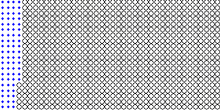Cyclic Melting/Solidification in a Cavity


An insulated rectangular cavity holds a pure material at it melting temperature. At time t = 0 the left hand wall is subjected to a cyclic temperature change which leads to a melting-solidification cycle. The simulation (using a uniform grid of 20x40 nodes) shows two cycles.
Note that
- during melting—the rising hot fluid leads to faster melting at the top of the cavity,
- when the solidification starts any temperature gradients in the liquid quickly dissipated and as a result the movment of solidification front is one-dimensional.
Voller’s research group have developed the so-called “Enthalpy Porosity” method for numerical simulation of this problem using a single fixed grid throughout the domain.
Approriate governing equations are

where (data is for gallium)
- u is the x-velocity, v is the y-velocity—(m/s)
- p is pressure (Pa)
- T is temperature (K)
- n=2.97 10-7 is the kinematic viscosity
- b=1.3054 10-4 K-1 is the thermal expansion—The Boussinesq buoyancy treatment is invoked.
- Tm=0 is the phase change temperature
- a = 1.4145 10-5 m2/s is the thermal diffusivity
- L = 80160 J/kg is the latent heat
- c = 409.58 J/kg-K is the specific heat
- f is the liquid fraction [0, 1]
- Su=-K0(1-f)u -- similar for Sv-- is the “porosity” source term (Kv = 105). As a nodal liquid fraction approaches 0 this term becomes large and forces velocity calculations to zero—as required by a static solid phase.
Typically the solution is based on a SIMPLE like routine for the pressure-velcoity coupling and an enthalpy solution for the heat transfer. The simulation shown here is taken from
- V.R. Voller, P. Felix, and C.R. Swaminathan, Int. J. Num Meth. Heat and Fluid Flow, 6, 57-64, 1996.
The original papers that mentions the term enthalpy porosity is
- A.D. Brent, V.R. Voller and K.J. Reid, Numerical Heat Transfer 13, 297-318, 1988.
This work was based on earlier ideas in
- V.R. Voller, M. Cross and N. Markatos, Int. J. Num. Meth. Eng. 24, 271-284, 1987.
- S.E. Hibbert, N.C. Markatos and V.R. Voller Int. J. Heat Mass Transfer 31, 1785-1795, 1988.
- V.R. Voller and C. Prakash, Int J. Heat Mass Transfer 30, 1709-1719, 1987.
Refinements and further discussions on the enthalpy-porosity methods can be found in
- V.R. Voller, “Numerical Methods for Phase Change Problems,” Chapter 19 in HandBook for Numerical Heat Transfer, 2006.
- V.R. Voller, Advances in Numerical Heat Transfer 1, 341-375, 1996.
- V.R Voller and S. Peng, Computational Mechanics 14, 492-502, 1994.
- V.R. Voller and C.R. Swaminathan, Numerical Heat Transfer B 24, 161-180, 1993.
- C.R. Swaminathan and V.R. Voller, Int. J. Num. Meth. Heat and Fluid Flow 3, 233-244, 1993.
- C.R. Swaminathan and V.R. Voller, Met. Trans. B 23, 651-664, 1992.
- A.T. Chronopoulous, C. Swaminathan and V.R. Voller, J. Super. Comp, 5 74-91, 1991.
- V.R. Voller and C.R. Swaminathan, Numerical Heat Transfer B 19, 175-189, 1991.
- V.R. Voller, Numerical Heat Transfer B 17, 155-169, 1990.
- V.R. Voller, C.R. Swaminathan and B.G. Thomas, Int. J. Num. Meth. Eng. 30, 875-898, 1990.
- M. Lacroix and V.R. Voller, Numerical Heat Transfer 17, 25-42, 1990.